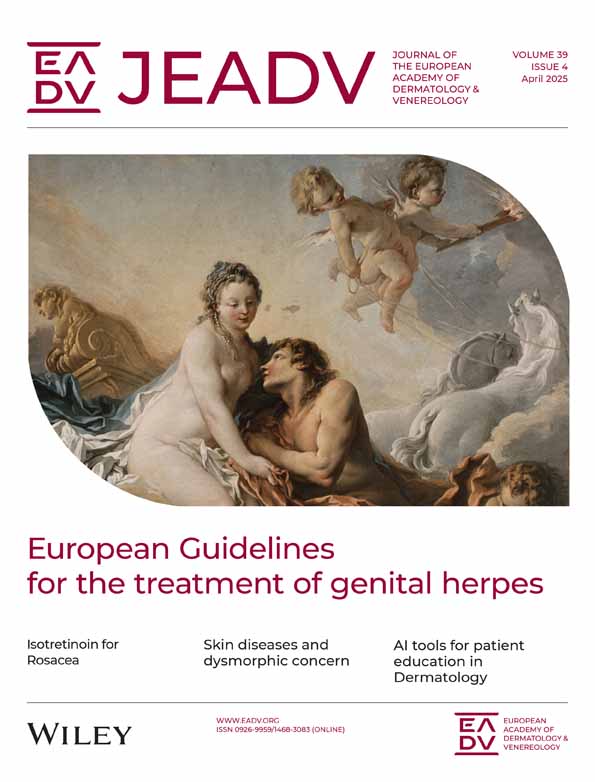Low-dose isotretinoin for difficult-to-treat rosacea: Enough evidence to be convinced—What's next?
Linked article: A. King et al. J Eur Acad Dermatol Venereol. 2025;39:785–792. https://doi.org/10.1111/jdv.20315.
Olivier Chosidow and Esther J. van Zuuren contributed equally to this work.
Rosacea is a chronic inflammatory skin condition principally affecting the centrofacial area and eyes, characterized by periods of remission and exacerbation. Its prevalence ranges from <1% to 22%, typically presenting in middle-aged adults. As a visible facial dermatosis, rosacea significantly impacts quality of life, with severity directly correlating to its effect on patients' well-being. The diagnosis and classification of rosacea now rely on presenting signs and symptoms, following a phenotype-based approach.1 In real-life settings, severely affected patients, for example, those experiencing psychosocial distress, extensive signs, disabling symptoms, poor tolerance to or failure with topical treatments, often require more advanced management. Oral doxycycline is then the drug of choice for inflammatory papules/pustules, and ocular rosacea, either as a modified-release dose of 40 mg or standard dose of 100 mg daily.1 Azithromycin may also be used. However, for ‘difficult-to-treat’ rosacea, that is, doxycycline-refractory or frequently relapsing cases, there has been unmet needs for years. Some authors advocated the value of minocycline. Due to its association with unpredictable life-threatening severe adverse reactions such as autoimmune hepatitis, drug-induced lupus erythematosus and DRESS, including severe myocarditis, the French health authorities restricted its prescription to specific infectious diseases in 2012.2 High-quality evidence now shows that low-dose isotretinoin is a safe and effective alternative.3, 4 This approach is further explored in the systematic review by King et al.5
The systematic review addresses an important topic—the efficacy and safety of isotretinoin for rosacea—but suffers from significant methodological limitations. While the authors claimed to use GRADE for assessing study quality and certainty, they conflated risk of bias with certainty of evidence and provided no detailed assessments using the Cochrane risk of bias tool or ROBINS-I as outlined in their protocol. Additionally, the reported GRADE scores lack sufficient transparency, as the authors do not provide enough details regarding their methodology, which does not align with the GRADE working group's criteria. The data of the study by Ertl et al. were deemed flawed in another review.4 Moreover, the 47% dropout rate in the Aksoy study further limits the reliability of the findings. When the effect is large and the sample size is small (or modest), the optimal information size should be calculated, and the certainty of evidence is likely to be downgraded for risk of bias, heterogeneity and imprecision resulting in very low certainty. Despite these concerns, the authors have organized substantial data in a structured manner and the fact remains that all studies support the results of included well-conducted studies weighing the most.3-5
In conclusion, this systematic review confirms the effectiveness of low-dose isotretinoin within acceptable limits, and, in fact, all collective evidence in the literature strongly supports its use for the attack phase of papules and pustules of rosacea. Regarding the safety concerns of isotretinoin, most are predictable and dermatologists are well aware of the critical importance of rigorous pregnancy monitoring in women of childbearing age. In contrast to the favourable benefit–risk ratio of low-dose isotretinoin in difficult-to-treat rosacea and the high expectations of the patients, the lack of official approval continues to limit its routine prescription. A marketing authorisation would be welcome either company-supported or using a public social security law, as in France where a ‘compassionate prescription’ approach may be requested. (https://www.legifrance.gouv.fr/eli/loi/2020/12/14/ECOX2023815L/jo/texte), based on a scientific application and supported by the French National Agency for the Safety of Medicines and Health Products (ANSM). Nevertheless, important gaps in the evidence still exist, particularly concerning the maintenance regimen, as papules and pustules of rosacea are part of a chronic disease with frequent relapses and the uncertain efficacy of isotretinoin in phymatous and ocular rosacea.
ACKNOWLEDGEMENTS
Thank you to Marie Beylot-Barry, Frédéric Caux, Bernard Guillot and Léna Ronjat for their support.
FUNDING INFORMATION
None to declare.
CONFLICT OF INTEREST STATEMENT
None for the authors to disclose.
ETHICS STATEMENT
Not applicable.
Open Research
DATA AVAILABILITY STATEMENT
Data sharing not applicable to this article as no datasets were generated or analysed during the current study.




